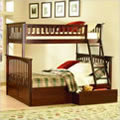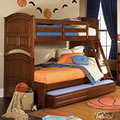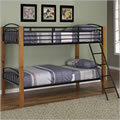Buyers' Guide: Basic Considerations
Basic Considerations
There are two practical matters any potential bunk bed buyer needs to consider before starting a serious research of the market:
the bed's main purpose -- who will be using it
spatial considerations -- where it's going to be located
Why are you buying this bed? Is it going to be used by a child or an adult, a boy or a girl, one person or more? Will you put it in the main bedroom, kid's bedroom, guest room? Let's examine a few illustrations. For two smaller children, a standard, twin over twin bunk bed will in all likelihood work just fine; however, if one of the kids is significantly older, she/he will probably need more sleeping space, in which case a twin over full configuration would be more appropriate. The same arrangement could do great in sleepover situations too, as well as for accommodating guests. Still, in the latter example full bunk beds would be an even better choice -- if needed, one of these can comfortably take in an entire family.
The age of a child is also a factor to be considered; for a younger kid, you might be more comfortable with a low loft bed, possibly equipped with a tent or some similar structure to increase the fun factor. School-age kids, however, will have different priorities; they might need a place to sleep that will double as a working space -- one of the workstation bunk beds with desk will fit the role perfectly. Or, if a leisure area combined with a sleeping spot is what you're after, don't miss out on futon bunk beds. The intended use, as you can see, can be quite helpful in determining the type of bed best suited to your requirements.
The spatial considerations are even more obvious -- you simply need to make sure the bed will fit into the room you intend to put it in. The first thing to check is the height; there has to be enough space left between the top of the bed and the ceiling so that the child or whoever is going to sleep in it can sit up straight without bumping their head or feeling claustrophobic. A regular bunk bed, with comfortable amount of space between the bunks, goes up to the height of about 65 to 75 inches; since the standard height of the ceiling is 8 feet, in most rooms there will be no problems -- except, of course, if the person sleeping on the top bunk is 7 feet tall.
The height of a bunk bed might be an issue, however, in low ceiling spaces -- whether they were architectured that way deliberately or out of necessity -- some loft rooms, for example, belong in this category, especially those with a slanted ceiling. Putting a standard-height bunkbed in such a space might not be the best idea, however, don't despair just yet; certain manufacturers do not follow the accepted standards and make their beds lower than is customary -- the Powell White Twin Bunk Bed is just such an example. Some comfort is inevitably sacrificed this way, but you might find it to be an acceptable trade-off.
Low loft beds are a different and probably better way to solve this problem; since the total height of such a bed usually does not exceed 50 inches, they can fit in pretty much everywhere, while still providing the kids with that special feeling that comes with sleeping on a bunk bed. The Berg Sierra Captain's Bed Collection features a few excellent solutions in this department, as do many of the Maxtrix Kids bunk beds.
Bottom line: each bed reviewed at this site has its measurements set out in the features section. Measure your available space, than compare the figures to see if it would fit without cramping the room. You wouldn't want to order one of those elaborate structures with steps or a ton of storage or something of a similar nature, and then have nowhere to put it.

Night and Day Ginger Twin over Full Bunk Bed in Cherry
Best Price: $829.99

Atlantic Furniture Columbia Twin over Full Bunk Bed
Best Price: $595.99

Lea Industries Deer Run Twin over Full Bunk Bed
Best Price: $1,123.50

Powell Country Pine and Matte Black Twin over Twin Bunk Bed
Best Price: N/A

